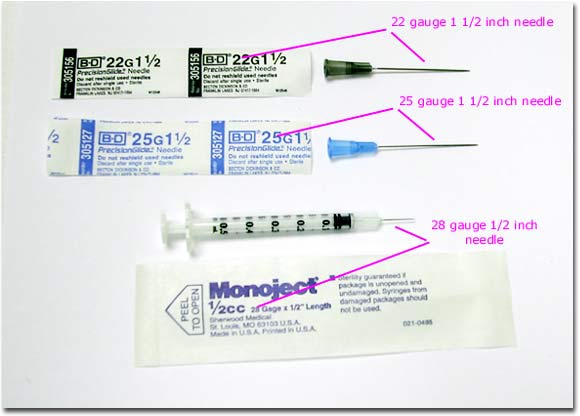|

The size of the needle is important. The length of the needle determines how deeply the injection can be placed. The diameter of the needle determines what types of solution can be pushed through the needle and (partially) how much the injection will hurt when the needle is entered through the skin.
For SQ injections the needle should be about 1/2 inch (or up to 2 centimeters) long. The needle is generally inserted at a 45-60 degree angle to reach the subcutaneous injection site (just under the skin). If a deep SQ injection is desired, such as with drugs that irritate the skin, then the angle can be 90 degrees (so that the injection site if a bit farther from the skin).
For IM injections the needle must be able to reach the interior of the targeted muscle tissue. IM needles generally are 1 1/2 inches long. The needle is generally inserted at a 90 degree angle and advanced to the hub (stopping if any resistance is met).
The diameter of the needle is associated with the gauge (G) of the needle, with higher gauge (such as 28 G) needles having a smaller diameter than lower gauge (such as 22 G) needles.
Oil based solutions (such as “progesterone in (sesame or peanut) oil”) are “thick” and very difficult to push through a 23 G or thinner (higher G) needle. Therefore, I usually suggest a 22 G needle for oil based medications.
Water based solutions (such as Pergonal or any of the menotropin medications) can be pushed through very narrow needles (such as a 28 G needle). For IM length needles, 25G is about the narrowest needle that will not bend on insertion. Most women find that injections with a 25 G needles are almost “painless.” For SQ length needles, 27 or 28 G needles are ideal since they are also almost “painless.”
|

|